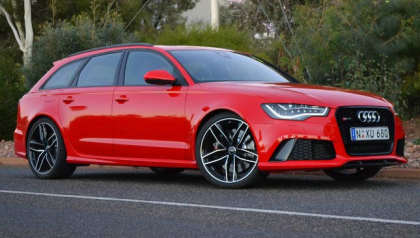It is the fastest and most powerful car Australia has ever produced -- and likely ever will produce. And we’ve got the first one freshly minted off the production line.
There really was only one place to take the new Holden Special Vehicles GTS: the high temple of horsepower, Mount Panorama Bathurst.
We wouldn’t be allowed to cut loose like the late great Peter Brock or the myriad of modern-day Holden V8 Supercar heroes. Mount Panorama is, after all, a public road with a 60km/h speed limit when it’s not being used as a race track.
But we weren’t complaining. Having sampled the new HSV GTS in all its glory at Phillip Island a month ago we have no doubt about the car’s giant-killing ability (see sidebar).
Want the short version of this road test? The new HSV GTS is pin-your-ears-back awesome. In addition to the slingshot acceleration it has a level of grip not seen before on an Australian performance car, due in no small part to a clever electronic solution borrowed from Porsche that keeps the rear end glued to the pavement no matter what.
A quick recap: until the updated $250,000 Mercedes-Benz E63 AMG arrives in Australian showrooms later this month the HSV GTS will briefly be the most powerful sedan of its size in the world.
The car that starts life as a Commodore has borrowed the epic supercharged 6.2 litre V8 from North American racing versions of the Corvette and Camaro -- and a Cadillac.
Installing the engine and all the other necessary hardware was the largest joint engineering effort by Holden and its performance partner HSV in their 25-year marriage. (The car starts life on Holden’s Adelaide production line before the finishing touches are added at HSV’s facility in the Melbourne suburb of Clayton).
If you’re unclear what a supercharger is all you need to know is that it’s the equivalent of a massive pump that force-feeds more air into an already formidable engine. You need plenty of oxygen to burn plenty of petrol. And when you burn plenty of petrol you make plenty of power. And the HSV GTS has that in spades (430kW of power and 740Nm of torque for the tech heads -- or more grunt than a V8 Supercar race machine for the non-converted).
For now I’m just trying to navigate Melbourne’s stop-start peak hour traffic and not scratch the first HSV GTS to leave Clayton without the supervision of the company’s engineers. The early signs are good: I haven’t stalled it. The first surprise is that despite the heavy-duty hardware, the manual gearbox and clutch are light and easy. Not quite like a Toyota Corolla, but not like a Kenworth either.
TECHNOLOGY
I quickly discover the dial in the middle of the console (borrowed from the new Corvette) that changes the exhaust note as if it were a volume knob. One turn of the noise dial won't quite wake up the neighbours, but those in the traffic around you will hear the extra bass from the mufflers.
It’s just one part of a suite of technology that’s in the new HSV GTS. You can personalise settings for the suspension, steering, throttle and stability control at the tap of the touchscreen or a turn of the dial. In fact, the new HSV GTS has more computer gadgetry than the geek icon, the Nissan GT-R.
The mapping for every race track in Australia is already preset -- and there is room for six others if and when they eventually get built (fingers crossed). In reality, though, after you’ve shown-off the system to a few mates you’re rarely likely to delve into its depths.
ON THE ROAD
But that’s not going to stop us. Heading north up the Hume towards Bathurst we’re effectively retracing the same path that Brock, Moffatt and co took when the racing legends drove their race cars to Bathurst in the golden era of the sport. The traffic is of course a lot worse these days -- but the roads are better, albeit dotted with speed cameras seemingly every few kilometres.
On the northern outskirts of Melbourne we drive past the front door of the Broadmeadows head office and car assembly line of Ford, a formidable Holden rival for the past 65 years. Ford fans are hoping the Blue Oval brand will deliver one last hero car before the Falcon bows out in 2016. If it does, this HSV GTS is the car they will be trying to beat.
As anyone who has travelled the Hume Highway knows, the road is achingly dull. But the new HSV GTS removes much of the boredom. As with the Holden Calais-V on which it is based it has a digital display of the vehicle’s speed reflected into the windscreen in the driver’s line of sight.
It also has a forward crash alert warning if you’re about to hit the car in front, and a lane departure warning if you cross white lines without indicating. Technophobes can turn these systems off. But I left the speed display on. It’s amazing how relaxing it is not having to avert your eyes to check the speedometer every few moments -- even if you are set in cruise control.
The route to Bathurst from Melbourne is fairly straightforward, and not as winding as the trip from Sydney over the Blue Mountains. In effect, you turn left a little north of Albury on the NSW-Victoria border, zig-zag your way to the fringes of Wagga Wagga and then it’s almost a straight line coming into the back of Bathurst.
Unlike the Hume, there aren’t service stations and fast food chains every half hour. And the road is not as well kept. Which was both good and bad, for it threw up some nasty potholes and bumpy bends that had us wondering at times if we may need the spare tyre, which is a space-filler as opposed to a space-saver.
Because HSV needed extra room under the car for the massive heavy-duty differential (it’s about the size of an outboard boat motor) and its cooling equipment, the spare wheel is secured on top of the boot floor, not below it. But at least you get a spare. European performance sedans come with an inflator kit and the phone number of a tow truck service. Out here you’d be waiting a while.
Finally we reach Australia’s motorsport mecca. It’s late in the afternoon and road workers are busy finishing yet more track upgrades before October’s Great Race. During a symbolic one-lap look-around we share the mountain pass with tourist coaches, local P-platers and fitness freaks on foot using the steep climb to get their hearts racing.
No matter how many times I’ve been here, though, Mount Panorama never ceases to amaze. The steep incline, corners which seemingly fall away and sheer cliff faces mean that it wouldn’t pass modern regulations if it were built from scratch today. Yet it survives because it is a part of history -- and because of countless costly upgrades. Sadly, the homegrown Holden Commodore will soon be assigned to the history books. When this generation Holden Commodore bows out in 2016 it will be replaced by a front-drive sedan which may or may not be built in Australia.
That leaves the new HSV GTS as a fitting exclamation point for the Australian car industry, and a future collector’s item. It is the result of every piece of Australian automotive knowhow in one car (albeit with a little help from a North American supercharged V8). No matter how you look at it, though, there will not ever be a homegrown car like this ever again. And that is a tragedy.
ON THE TRACK
The new HSV GTS is epic on the road but you need a race track to explore its full potential. Thankfully HSV hired one for the day. HSV claims the new GTS can do the 0 to 100km/h dash in 4.4 seconds with automatic transmission (yes, it’s faster than the manual off the line, but the manual is faster once you’re already on the move). The best 0 to 100 times we could get out of the manual were a string of easily achievable 4.7-second runs. In launch control mode it did 4.8-second runs ad nauseum.
Acceleration is only one part of the story, however. The handling has stepped up a notch. Finally, the magnetically-controlled particles in the suspension deliver on the promise of comfort and handling. The GTS now rides better over bumps than the HSV Clubsport.
Best of all you can feel the computer magic dabbing the rear brakes to help control the rear end from sliding out. The electronic torque vectoring is the same type of technobabble that Porsche uses. At first you think your driving skills have improved. Then reality sets in.
The highlight for me, though, apart from the obvious adrenalin from the acceleration, is the new brake package. They are the biggest brakes ever fitted to an Australian-made production car. And they are superb. They have a precise feel typically found on sports cars, not 1850kg sedans. There is no doubt the new GTS is the most complete package HSV or Holden has ever built. We don’t hand out such accolades lightly, but the team that created this machine should take a bow.
HSV GTS
Price: $92,990 plus on-road costs
Engine: 430kW/740Nm supercharged 6.2-litre petrol V8
Transmission: six-speed manual or six-speed auto ($2500 option)
Weight: 1881kg (manual), 1892.5kg (auto)
Economy: TBA
Safety: six airbags, five-star ANCAP rating
0 to 100km/h: 4.4 seconds (claimed)
Service intervals: 15,000km or 9 months
Spare tyre: Full size (above boot floor)
HSV GTS 2013:
| Engine Type | V8, 6.2L |
|---|---|
| Fuel Type | Premium Unleaded Petrol |
| Fuel Efficiency | 14.8L/100km (combined) |
| Seating | 5 |
| Price From | $70,510 - $81,070 |
| Safety Rating |
|






























.jpg)























-w.jpg)


.jpg)
.jpg)
Comments